Itinerary edited by UNIVERSITY OF CAGLIARI 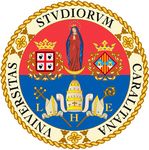

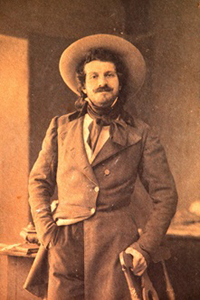 Evangelista Gennaro Gorga was born in Brocco (now Broccostella, in the Roman hinterland), on 6th February 1865. His family was part of the local nobility. From an early age he had the chance to pursue his love of music and studied piano and voice in Rome, where his parents sent him to attend the best schools.
Evangelista Gennaro Gorga was born in Brocco (now Broccostella, in the Roman hinterland), on 6th February 1865. His family was part of the local nobility. From an early age he had the chance to pursue his love of music and studied piano and voice in Rome, where his parents sent him to attend the best schools.
As a pianist and young man, Evan (the nickname he became famous with) started performing in aristocratic and upper-middle-class circles in Rome, and many appreciated his musical talent, wit, good looks and refined manners.
His interest in musical instruments (mainly old and antique instruments he repaired himself) led him to create the first and most important nucleus of his collections. Such an interest stemmed both from his innate passion for music and the experience he had gained while working from an early age in the piano shop his brother had opened in Rome in Via del Corso.
With the help of his brother, he became a skilful artisan who created, restored and tuned pianos, organs and harmoniums; he was also called upon to tune all the pianos belonging to the queen of Italy and the whole royal family.
However, Gorga would go down in music history thanks to his gifts as an opera singer. Although he had studied voice as a tenor, he got his start as opera singer by chance. He was called to replace his friend Francesco Tamagno, who was scheduled to perform in the title role of Verdi’s Ernani but fell sick. Gorga reluctantly accepted; he was such a success in the role that in opera circles he would be introduced as a “phenomenal tenor”.
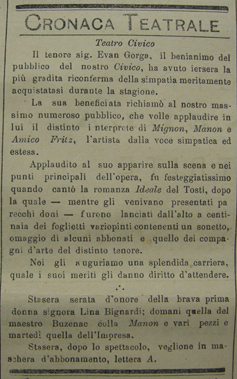
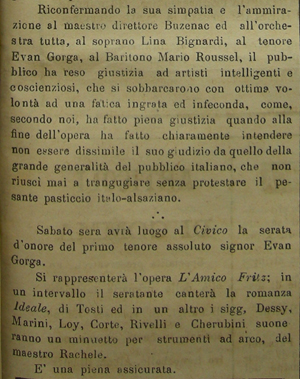 Gorga’s ties to the city of Cagliari started with his debut as “Primo Tenore Assoluto” (First Absolute Tenor) in the “Stagione di Carnevale” that took place at the Teatro Civico di Cagliari from1st January to 27th February 1895. He performed the roles of Wilhelm Meister in Ambroise Thomas’s Mignon, Le Chevalier des Grieux in Jules Massenet’s Manon, and Fritz Kobus in Pietro Mascagni’s L’amico Fritz. He was so successful that on 23rd February a soiree was held to celebrate him and a sonnet was composed for the occasion on “colourful small paper by some theatre subscribers and art fellows”, as reported on the entertainment section of the local newspaper Unione Sarda on 24th February 1895 (cf. two extracts from the Unione Sarda dating respectively 22 and 24 February 1894).
Gorga’s ties to the city of Cagliari started with his debut as “Primo Tenore Assoluto” (First Absolute Tenor) in the “Stagione di Carnevale” that took place at the Teatro Civico di Cagliari from1st January to 27th February 1895. He performed the roles of Wilhelm Meister in Ambroise Thomas’s Mignon, Le Chevalier des Grieux in Jules Massenet’s Manon, and Fritz Kobus in Pietro Mascagni’s L’amico Fritz. He was so successful that on 23rd February a soiree was held to celebrate him and a sonnet was composed for the occasion on “colourful small paper by some theatre subscribers and art fellows”, as reported on the entertainment section of the local newspaper Unione Sarda on 24th February 1895 (cf. two extracts from the Unione Sarda dating respectively 22 and 24 February 1894).
The music producer Giulio Ricordi heard Gorga sing during an audition and chose him to perform in the role of Rodolfo in Giacomo Puccini’s new opera La Bohème that would debut at the Teatro Regio di Torino on 1st February 1896, directed by Arturo Toscanini. Puccini had reservations because he feared Gorga could not cope with the strain of this performance (Gorga performing as Rodolfo. Image reprint permission kindly granted by his great niece M. Cristina). Fortunately, both Puccini’s opera and Gorga’s performance proved to be very successful and Gorga impressed the maestro with his talent. The day after the debut, Puccini paid Gorga a compliment by sending him a copy of the score of La Bohéme with the following dedication: To my talented first tenor as Rodolfo, Mister Evan Gorga. A souvenir from Giacomo Puccini.
In 1899, when he was 34 and at the height of his success, Gorga decided to give up performing. Apparently, his family and his extremely jealous wife Loreta D’Abundo (who thoroughly disliked the many love letters her husband received) forced him to stop. He decided to devote himself fully to his instrument collection, a hobby that was then considered as a more fitting pastime for a nobleman than performing onstage. Gorga was mainly interested in finding antique musical instruments; however, he would collect anything that might sound or look antique and any object that relatively honest antique dealers offered him. This passion bordered on obsession; thanks to the money he had earned during his performing career and through his wife’s estates, he could buy, exchange and sell items at will. In order to store his entire collection and make it available to an elite audience, he rented ten flats at 235 Via Cola di Rienzo in Rome. He divided his collection into 30 sections that amounted to 150,000 pieces in all.
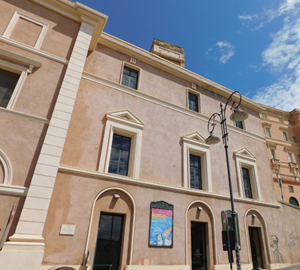
As he himself wrote, Gorga had the honour to let people admire what he defined as a Museum of Music History, “possibly the most complete museum of musical instruments that exists in the world” (G. M. Viti). He showed it to illustrious figures such as princes, politicians, intellectuals, music directors and musicians. His guests included Arturo Toscanini, Pietro Mascagni, Ottorino Respighi, the Duke of Aosta and the Infante of Spain.
The quality of his collections was so remarkable that in 1926 Giuseppe Maria Viti wrote: “when, for the first time, I found myself face to face with Gorga’s amazing collections, I was so astonished at their sheer size and complexity, and so fascinated by their secret, magical splendour. When I finally beheld this tenacious collector, I thought it impossible that one single person could have made such a titanic effort in such a relatively short time. In all honesty, it really required an effort that only several generations could have made”.
The section devoted to Gorga’s archaeological collection reached an impressive total of 40,000 pieces including antique bronzes, pottery, glass, stuccos, plasters and marbles. All these objects covered a time period from prehistory to the late Middle Ages. In 1929, however, Gorga’s difficult financial situation became untenable as he still had to pay the rent on ten apartments and continued acquiring pieces for his collections. He was thus forced to ask the government to confiscate all his collections so a part would not be auctioned off to pay his debts. In 1949, Gorga chose to donate all his collections to the Italian Ministry of Public Education, which in turn offered “to arrange and display the most interesting pieces in State-owned institutions”.
Evan Gorga died of pneumonia in Rome on 6th December 1957, aged 93. In 1964, Luisa Cervelli work hard to ensure that all Gorga’s collections were used to create the new National Museum of Musical Instruments in Rome.
6th February 1865 Evangelista Gennaro Gorga was born in Brocco (now Broccostella), in the province of Frosinone
1st January 1895 He made his debut at the Teatro Comunale di Cagliari as “Primo Tenore Assoluto”
1st February 1896 He was chosen by G. Puccini to perform in the role of Rodolfo in La Bohème, at the Teatro Regio di Torino
3rd October 1896 He successfully performed at the Politeama genovese in I Lombardi alla prima crociata
1899 He retired from the stage to devote himself fully to his collecting activity
1911 During the International Exhibition in Rome, 280 musical instruments from Gorga’s collection were exhibited at the Castel Sant’Angelo
1949 Gorga’s collections were acquired by the Italian government
1st January 1955 A part of Gorga’s archaeological collection was entrusted to the University of Cagliari
1990 The Archaeological Collection of the University of Cagliari became a permanent exhibition
2010 The Archaeological Collection of the University of Cagliari underwent restoration
6th December 1957 Gorga died of pneumonia in Rome, aged 93
1964 Gorga’s collections were displayed in the new National Museum of Musical Instruments in Rome
 Cagliari
Cagliari  Genoa
Genoa  Turin
Turin  Trento
Trento  Naples
Naples  Würzburg
Würzburg  Catania
Catania  Roma
Roma
Capodiferro A. (Ed.) (2013). Museo Nazionale Romano. Evan Gorga la collezione di archeologia. Catalogo della Mostra Evan Gorga. Il Collezionista (Roma, Palazzo Altemps, dal 19 ottobre 2013 al 4 maggio 2014), Electa, Milano.
(2010). «Evan Gorga». In Franchi S., Sartori O. (Eds.). Dizionario Storico Biografico del Lazio. Personaggi e famiglie nel Lazio (esclusa Roma) dall’antichità al XX secolo.
Cionci A. (2004). Il tenore collezionista: vita, carriera lirica collezioni di Evan Gorga. Firenze, Comune di Broccostella, Nardini Editore.
Barbera M. (Ed.) (1999). La collezione Gorga. Museo nazionale romano. Milano, Electa.
Trevisan S. (1999). La dispersione della Collezione Gorga (pp. 19-24). In Barbera M. (Ed.). La collezione Gorga. Museo nazionale romano, Milano, Electa.
Ibba M. A. (1994). La ceramica in bucchero, etrusco-corinzia e il“Dot-Wreath Plates Group” della Collezione Gorga dell’Università di Cagliari (pp. 5-20). In Annali della Facoltà di Lettere e Filosofia di Cagliari, n.s. XIII (L)- 1992/1994.
Ibba M. A. (1991). La ceramica a figure rosse e sovraddipinte della Collezione Gorga dell’Università di Cagliari (pp. 23-60). In Annali della Facoltà di Lettere e Filosofia dell’Università di Cagliari, n.s. XII (XLIX).
Pallottino L. (1967). Dalle rovine della Collezione Gorga al Museo nazionale degli strumenti musicali (pp. 263-272). In Palatino, 11., 4. serie, n. 3.
Cianfarani V. (1957). Rhython della Collezione Gorga (pp. 104-106). In Bollettino d'arte, 42., fasc. II aprile-giugno.
(1948). Collezioni Gorga: Raccolte archeologiche e artistiche, Roma, Istituto Poligrafico e Zecca dello Stato.
Viti G. M. (1926). Evan Gorga e le sue grandi collezioni. Roma, SPE.